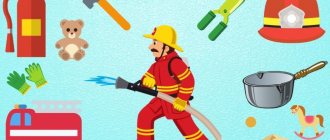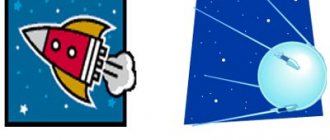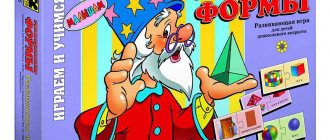Progress of the game:
Start of the game: get children interested with a poem
Look what happened
All the cars got lost.
Help the cars soon
And take them to the right garage
Card No. 1 . Children are invited to “put the car down”
to the garage the same color as the car:
Look, these are not simple garages, but colorful ones.
Take the car of the desired color
And take it to the right garage.
Card No. 2. It is necessary to select a machine in accordance with the size of the garage:
Well, look carefully
How are the garages different here?
Large and small garage
Of course you will give me the answer.
Choose the right size machine
And take it to the right garage.
Card number 3. You need to choose a car according to the silhouette in the garage:
Look how different the garages are here.
Each one has its own machine,
Look at the picture and feel free to go ahead !
Didactic game “Our Street”
Target:
1. Expand children’s knowledge about the rules of behavior for pedestrians and drivers on the street;
2. Strengthen children’s understanding of traffic lights;
3. Teach children to distinguish road signs (warning, prohibiting, prescriptive, informational, intended for drivers and pedestrians.
Material: model of a street with houses, intersections, cars (toys, pedestrian dolls, driver dolls, traffic lights (toy, road signs, trees (models)
.
A collection of didactic games on traffic rules for an early age group
Didactic game “What light is lit” Tasks:
consolidate knowledge of traffic light colors.
Equipment
: “Live picture” - a street, a picture of a traffic light with round holes, circles in red, yellow and green.
Contents of the game. The teacher
alternately inserts circles of different colors into the traffic light holes in the “Live Picture” and invites the children to name these colors and explain what they mean for pedestrians.
Didactic game “What does the traffic light say?” Objectives:
to form children’s elementary ideas about the meaning of the colors of the traffic light and the rules of the road.
Equipment:
“Live picture” - street, pictures: traffic lights, cars for various purposes;
road markings, figures of people. Contents of the game. The teacher
prepares a model of the road with pedestrian crossing markings, creates various traffic situations using human figures, and invites the children to show the correct behavior of pedestrians and drivers on the road.
Didactic game “What’s missing” Objectives:
consolidate knowledge about car parts.
Equipment:
pictures of cars, car parts.
Contents of the game. The teacher
shows the car, clarifies what is missing, then offers to find a picture with the missing part.
Didactic game “Our Street” Tasks:
to form children’s elementary ideas about the concepts: street, road, sidewalk, trees, houses;
basic understanding of the rules of behavior on the road. Equipment:
“Live picture” - a street, a picture of a traffic light with holes, circles of red, yellow and green colors, figures of children, pictures of cars, road signs.
Contents of the game. The teacher
shows the children a picture and tells them that when crossing the road, they should not rush, they must be careful, they must not play near the road, cross the road at a pedestrian crossing, distinguish between traffic lights (green - you can go, red - no movement), road signs .
Didactic game “What do we drive?” Objectives:
to teach children to recognize and show vehicles by ear.
Equipment:
pictures of vehicles.
Contents of the game. The teacher
reads a poem to the children, then asks what it says and asks the child to find a picture of this vehicle.
The steam locomotive
The locomotive hummed and the carriages were carried away.
Chu-choo, choo-choo! I'll take you far! (T. Volgina) Truck
No, in vain we decided to Ride the cat in the car: The cat is not used to riding - He overturned the truck.
(A. Barto) Airplane
We’ll build the airplane ourselves, Let’s fly over the forests.
Let's fly over the forests, and then return to mom. (A. Barto) Helicopter
Helicopter, helicopter!
Take me on a flight! And in flight it’s empty, cabbage has grown! (teaser) Ship
Sailor cap, rope in hand.
I’m taking a boat along a fast river, and the frogs are jumping on my heels, and they ask me: “Give me a ride, captain!” (A. Barto) Didactic game “What do we drive?” Objectives:
to teach children to recognize familiar vehicles, to designate them in words.
Equipment:
“Live picture” - street, pictures of vehicles.
Contents of the game. The teacher
one by one inserts pictures of vehicles into the holes in the “Live Picture” and asks what is drawn on it.
Children answer on their own or with the help of a teacher. Then the teacher offers to look at the picture and notes what color the machine is, what it is needed for, and together with the children names its parts, etc. Didactic game “Let me tell you something” Tasks:
Fix the name of the transport, activate the dictionary.
Equipment:
toys bus, truck, car, plane, boat.
Contents of the game.
Toys are on the table or carpet.
The child is at a distance of 1-2 meters from the table. The teacher asks the child: “Bring a bus (plane, truck, etc.).” If the child finds it difficult, the teacher clarifies: “It is red, standing near the plane,” or simply points to the desired toy. Then he asks questions, specifying what the child brought, what color the bus is, its size; look at its parts. Didactic game “Wonderful Bag” Objectives:
Clarify and activate the vocabulary on the topic “Transport”.
Equipment:
Toys: bus, truck, car, airplane, boat, bag.
Contents of the game. The teacher
takes the cars out of the bag one by one. Together with the child, he examines and discusses their appearance (truck, bus, etc.), color, material, purpose. Specifies the name of the parts, their color and shape.
Progress of the game
The game is played on a layout
First option (for pedestrians)
With the help of dolls, children act out various road situations. So, at a controlled intersection, when the traffic light is green, the dolls cross the street, when the traffic light is yellow they stop and wait, and when the traffic light is red they continue to stand.
“Pedestrian Crossing” sign.
, and there they cross the roadway.
Second option (for drivers)
The presenter shows road signs: “Traffic light regulation”
,
“Children”
,
“Pedestrian crossing” (warning)
;
“Entry prohibited”
,
“Bus stop location”
,
“Underground passage” (informational and indicative)
. Children explain what each signal means and act out traffic situations.
For the correct answer, the child receives a badge. The number of icons is used to calculate the points scored.
Didactic game “Different machines are needed, different machines are important”
Target:
1. Introduce children to the different types of vehicles that people need: a passenger car, a fire truck, an ambulance, a dump truck, a truck, a crane, a bakery, a bus;
2. Learn to distinguish them by appearance and name them correctly;
3. Know their purpose and understand their significance in a person’s life;
4. Learn to assemble a whole picture from two parts
Description: This material will help the teacher organize work with children 2-3 years old and their parents to develop basic knowledge of road safety rules. Didactic game “Which light came on” Objectives: consolidate knowledge of traffic light colors. Equipment : “Live picture” - a street, a picture of a traffic light with round holes, circles in red, yellow and green. Contents of the game. The teacher alternately inserts circles of different colors into the traffic light holes in the “Live Picture” and invites the children to name these colors and explain what they mean for pedestrians. Didactic game “What does the traffic light say?” Objectives: to form children’s elementary ideas about the meaning of the colors of the traffic light and the rules of the road. Equipment: “Live picture” - street, pictures: traffic lights, cars for various purposes; road markings, figures of people. Contents of the game. The teacher prepares a model of the road with pedestrian crossing markings, creates various traffic situations using human figures, and invites the children to show the correct behavior of pedestrians and drivers on the road. Didactic game “What’s missing” Objectives: consolidate knowledge about car parts. Equipment: pictures of cars, car parts. Contents of the game. The teacher shows the car, clarifies what is missing, then offers to find a picture with the missing part. Didactic game “Our Street” Objectives: to form children’s elementary ideas about the concepts: street, road, sidewalk, trees, houses; basic understanding of the rules of behavior on the road. Equipment: “Live picture” - a street, a picture of a traffic light with holes, circles of red, yellow and green colors, figures of children, pictures of cars, road signs. Contents of the game. The teacher shows the children a picture and tells them that when crossing the road, they should not rush, they must be careful, they must not play near the road, cross the road at a pedestrian crossing, distinguish between traffic lights (green - you can go, red - no movement), road signs . Didactic game “What do we drive?” Objectives: to teach children to recognize and show vehicles by ear. Equipment: pictures of vehicles. Contents of the game. The teacher reads a poem to the children, then asks what it says and asks the child to find a picture of this vehicle. The steam locomotive The locomotive hummed and the carriages were carried away. Chu-choo, choo-choo! I'll take you far! (T. Volgina) Truck No, in vain we decided to Ride the cat in the car: The cat is not used to riding - He overturned the truck. (A. Barto) Airplane We’ll build the airplane ourselves, Let’s fly over the forests. Let's fly over the forests, and then return to mom. (A. Barto) Helicopter Helicopter, helicopter! Take me on a flight! And in flight it’s empty, cabbage has grown! (teaser) Ship Sailor cap, rope in hand. I’m taking a boat along a fast river, and the frogs are jumping on my heels, and they ask me: “Give me a ride, captain!” (A. Barto) Didactic game “What do we drive?” Objectives: to teach children to recognize familiar vehicles, to designate them in words. Equipment: “Live picture” - street, pictures of vehicles. Contents of the game. The teacher one by one inserts pictures of vehicles into the holes in the “Live Picture” and asks what is drawn on it. Children answer on their own or with the help of a teacher. Then the teacher offers to look at the picture and notes what color the machine is, what it is needed for, and together with the children names its parts, etc. Didactic game “Let me tell you something” Tasks: Fix the name of the transport, activate the dictionary. Equipment: toys bus, truck, car, plane, boat. Contents of the game. Toys are on the table or carpet. The child is at a distance of 1-2 meters from the table. The teacher asks the child: “Bring a bus (plane, truck, etc.).” If the child finds it difficult, the teacher clarifies: “It is red, standing near the plane,” or simply points to the desired toy. Then he asks questions, specifying what the child brought, what color the bus is, its size; look at its parts. Didactic game “Wonderful Bag” Objectives: Clarify and activate the vocabulary on the topic “Transport”. Equipment: Toys: bus, truck, car, airplane, boat, bag. Contents of the game. The teacher takes the cars out of the bag one by one. Together with the child, he examines and discusses their appearance (truck, bus, etc.), color, material, purpose. Specifies the name of the parts, their color and shape.
Progress of the game:
Before the trip, agree with the children who will collect what type of transport (for clarity, you can distribute pictures of trucks and cars, you can also take specialized transport: police, firefighters, ambulance, etc.). On the way, children pay attention to the cars, naming them and receiving chips for this. Whoever collects the most wins.
Didactic game “Red, yellow, green”
Goal: development of attention, memory





